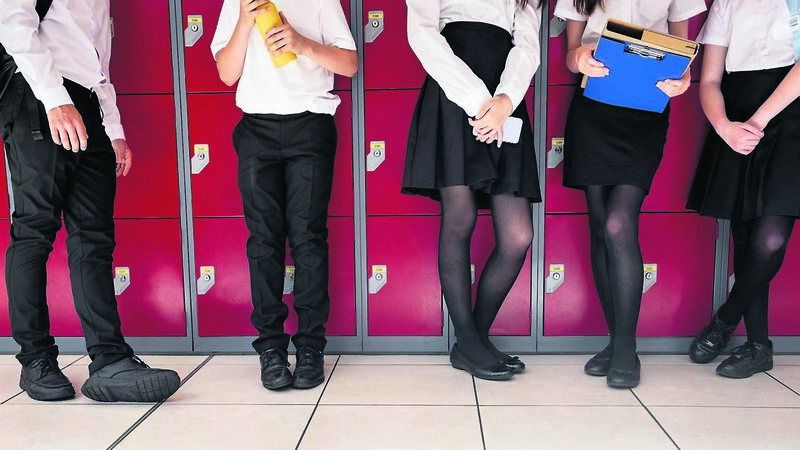MANY column inches are dedicated to back-to-school issues at this time of year, but one topic is often overlooked: the transition to second year.
While I recognise the importance of the first day in primary school and the challenges of moving to secondary school, second year is one of the most significant developmental periods for children. The leap from first to second year sees a move away from parental and adult control towards peer and group influence.
It’s easy for parents to believe second-year students need little support as they have already navigated the transition to secondary school. Yes, there may have been some initial teething problems but your child now seems more comfortable at school, is used to carrying a heavy schoolbag, is familiar with multiple teachers, is mastering timetables and navigating the geography of a large school building. Their school reports at Christmas and summer may also have seemed OK, giving the impression that all is going according to plan.
However, stepping back can be a mistake, based on my experience of working with teenagers. The second year of secondary school is crucial in a child’s social trajectory. The establishment of friendships and interactive patterns during this time is pivotal to their future school years.
It is usually in second year that the culture of the peer group starts to form and the dynamics established. A popularity hierarchy is created, so a series of jostling for social positioning usually occurs. Their confidence has also grown, leading to greater assertiveness and confidence. We might welcome these attributes, but they may give rise to problematic dynamics within their social grouping.
By contrast, in first year, almost everything is new, children are often overwhelmed, and they tend to concentrate on ‘finding their feet’. The arrival onto a campus where you are at the lowest point in the social chain can be a sobering experience to even the most confident. It can act as a social leveller when it comes to group power dynamics. That’s not to say bullying and exclusion don’t occur in first-year groups, but the escalation of such behaviours in the second year is noticeable.
Mental health issues
It is well established from referral rates that many mental health problems occur during middle adolescence. Also, an often-quoted statistic from Mental Health UK indicates that more than 50% of adult mental health problems begin at 14.
We need to take other factors into account. Social independence and alcohol consumption usually occur around this time, and it is also when we see a drop in numbers engaging in sports and other extracurricular activities. The interest in identity and how they dress, look and act comes more into focus.
This is true for boys and girls and the differences between genders are becoming less noticeable. In my clinical experience, more boys are becoming victims of exclusion, a tactic traditionally observed in girls. An increase in physically violent episodes is being reported among groups of girls, which in the past would have been more usually associated with boys.
Second year typically marks the move from one-on-one friendships, ‘best friends’ to a group dynamic where young people identify in larger groups and the power hierarchy is established. And many will experience a hormone surge around this time.
Parents often ask me “is X a good school?” or “is Y a bad school?”. I usually say the issue is not whether the school is good or bad because the most influential factor is the culture of the class your child is in. A school may have an excellent ethos, but the third-year group could be particularly problematic, or conversely, there might be a so-called ‘underperforming school’ but the fifth-year group has a lovely supportive dynamic. Also, as someone who has worked as an educator in several third-level institutions, I can vouch for how the culture of one year to another can vary considerably.
Because second year is such a formative period in the development of the culture of the year group, we need to pay particular attention to the back-to-school dynamics that occur in this year. I urge parents and teachers to be vigilant with this group during the first term, particularly regarding shifting classroom dynamics. While this is peak adolescent development and some personality changes are expected — an increase in irritability, a desire for independence, stepping back from the family, and growing closeness to their peer group — some changes may need more attention and support. For example, a child who was previously ‘happy go lucky’ but now appears more hostile, or who used to be quite social becomes more withdrawn, or who once went to school without issue now seems reluctant to go, or there is an increase in tummy aches and other ailments on Sunday nights.
Bullying behaviour
While we tend to focus on the victim of bullying or exclusion, we need to look out for signs that children may be the perpetrators of bullying behaviour. Watch for changes in your child’s demeanour to see if they are indeed the perpetrator of bullying or exclusion. Perhaps a change in their level of aggression or hostility or a shift to a more tough identity through fashion choices or music tastes might be indicative of someone who is experimenting with asserting their authority and while this is to be encouraged, it should never be at the cost of others.
Second year is a crucial time for young people to learn about ‘values’ and rewarding young people in this age group for their kindness, generosity, and understanding is particularly important. It may also be a good time to foster teamwork and get them working together on goals and mixing and diluting powerful groups within the year. Usually, there is a push to include these types of team-building activities in the transition year, but this is perhaps too late to have a cultural impact on the class.
I appreciate how busy school curriculums are. Still, I believe interventions that create an inclusive culture and systems that offer vigilant observation of problematic group dynamics are a worthwhile investment for second-year students.
Schools go to great lengths to support students during the induction period in first year. Continuing this level of support into second year, with the emphasis changing to social and moral guidance, would pay dividends for the rest of their time in school. Such an intervention would not require significant curriculum reform, simply an ongoing vigilance over the dynamics of the second-year group, with an emphasis on promoting values and teamwork and promptly addressing problematic dynamics.
If you can foster a culture of togetherness in second year, it could create bonds that last for that group’s entire school journey and into adulthood. It may also save teachers much time and effort in mediating interpersonal conflicts further down the line.
- Dr Colman Noctor is a child psychotherapist
CONNECT WITH US TODAY
Be the first to know the latest news and updates










